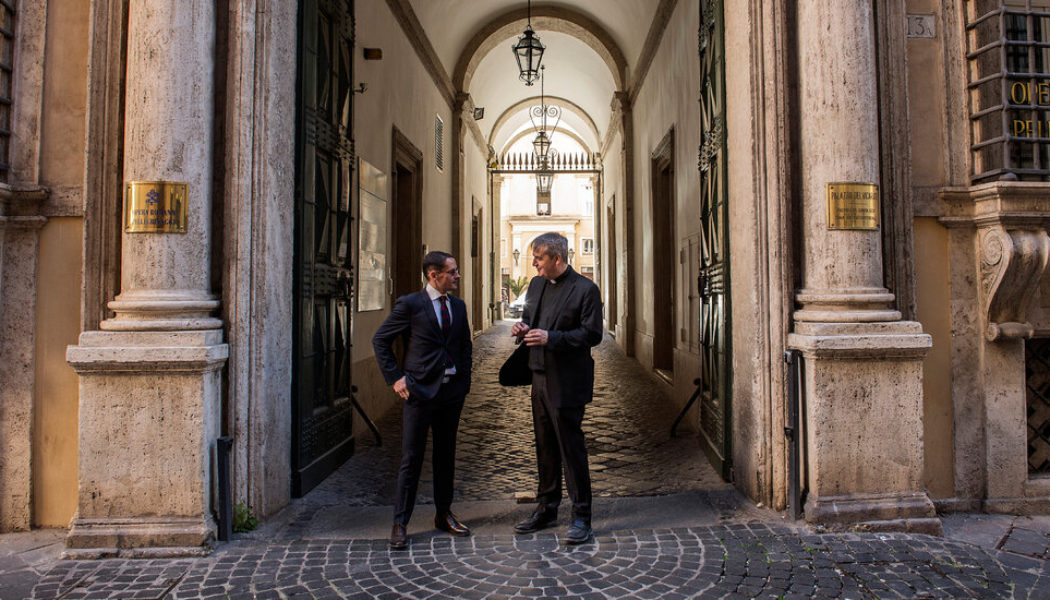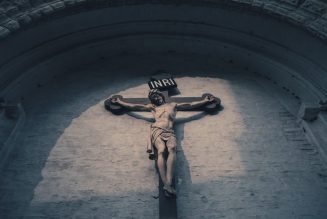
ROME — Pope Francis liked the floor plan.
“It’s a good space you have,” the pope, mapping out a square with his hands, said during a private audience last month to the Rev. Andrew Small, who manages the pope’s commission on combating sex abuse. “Have you moved yet?”
Since Francis created his Commission for the Protection of Minors in 2014, the staff has occupied cramped offices in an old Vatican residence near the pope’s apartment. While the location at first suggested a proximity to power, the commission has over the last decade seen its influence eroded by entrenched Vatican interests and defections. Father Small said its staff was forced to borrow office space around the Holy See “like Bedouins” when bishops came to meet with them. Survivors of abuse, he said, struggled to find their hard-to-find corner.
So in recent years, the commission quietly sought a change, or at least a change of address, to reassert the place that safeguarding children occupies in the church. That property hunt ended last month, when the commission took control of rent-free offices in a stately 16th-century palazzo controlled by the church in the middle of Rome.
The commission says the new offices, previously unreported, in Palazzo Maffei Marescotti, just down the street from the Pantheon, amount to a concrete commitment to victims and a clear response to Vatican forces that it believes would rather see the issue of sex abuse stay hidden or kept far away.
Far from an exile, Father Small characterized the move as an expansion to a global headquarters in Rome that can serve as a monument to “the silent massacre of people’s childhoods” and make clear to survivors that they “have a right to be somewhere beautiful.”
“It’s very significant,” Cardinal Sean O’Malley, the archbishop of Boston and the president of the commission, said in an interview.
Despite it being “nifty” to have been in offices a stone’s throw from the pope, he said, “We have come to realize that it’s not as accessible as we would like to be.” Survivors of clerical sex abuse, he said, often feel uncomfortable coming into a Catholic church: “To have to come into the Vatican and go through the Swiss Guards and the gendarmes and everything else can be pretty daunting.”
Location is far from the commission’s only problem. For decades, the church has been divided over the accountability of its hierarchy when it comes to covering up abuse, how much of a voice to give victims inside an insular institution and whether to take a more incremental or uncompromising approach to reform.
Francis announced the creation of the commission in 2013, amid concerns that he wasn’t serious about the issue, but it became purely advisory. Commissioners, including survivors, eventually quit in protest, accusing the Vatican of stonewalling.
New office or not, that period of instability is not over. Last month, the Rev. Hans Zollner, a German Jesuit who is arguably the Catholic Church’s leading expert on anti-abuse efforts and the commission’s most prominent member, quit too.
He questioned the commission’s independence and excoriated it for failing to provide “responsibility, compliance, accountability and transparency.”
Sexual Abuse in the Roman Catholic Church
“Father Hans has not been terribly present to us in the last year, so I was very surprised,” Cardinal O’Malley said of the barnburner statement, adding, “I don’t understand what his motivations for going are, but we will seek to understand and address his concerns.”
Asked if he thought Father Zollner, whom some commission staff suspected of trying to establish a competing child protection center at a Roman pontifical university, was trying to sabotage the commission, the Cardinal said, “At this point, I don’t know what he thinks.” (Father Zollner did not return a request for comment.)
Cardinal O’Malley preferred to talk about the opening of new safeguarding offices in South America and new accountability measures that Francis enshrined into church law last month.
The pope, he said, had explicitly approved of the visibility that the commission’s new headquarters provided in the heart of Rome, which, Cardinal O’Malley said, should help “allay fears that we’re being exiled out of the Vatican.”
But finding that space was no easy task.
Father Small, a Capitol Hill veteran from his time as foreign policy adviser to the U.S. Conference of Catholic Bishops, said that to find the right place he used Washingtonian lessons about “aligning interests,” and responded to slammed doors with a determined, “Well, we’ll see.”
Often, he said, he ran into a “NIMBY” attitude, where church landlords looked at the commission “like a methadone clinic.”
“No one wants it in their backyard,” he said.
In 2021, Father Small stumbled onto Palazzo Maffei Marescotti, a Holy See property outside the Vatican that houses charity offices, a post office and the church’s pilgrimage office. The former director of that office, Msgr. Liberio Andreatta, who is in charge of the building, lives in the palazzo and is a well-connected figure known in Roman clerical and political circles for his extensive real estate portfolio.
Cardinal O’Malley wrote a letter inquiring about the property or other suitable locations to the Vatican’s Secretariat of State and also reached out to APSA, the church’s real estate powerhouse, which essentially responded with a “no vacancy” sign.
The equivalent of the Vatican City mayor’s office also told the commission to forget any expansion plans in their existing Vatican offices, Father Small said, and informed them they might also be evicted to make room for cardinals in need of lodging in the event of a conclave to choose the next pope. (The Vatican declined to comment.)
Eventually, Father Small said his nudging and Cardinal O’Malley’s letter prompted Monsignor Andreatta to show some small rooms on the roof of the palazzo that Father Small described as “stuffed with pigeons.”
Last November, Cardinal O’Malley made an on-site inspection and was shown a series of dilapidated, high-ceiling rooms available if the commission would foot the bill for their restoration. As the commission considered a fund-raising campaign, a shake-up in the Rome vicar’s office brought in Bishop Baldassare Reina, a sympathetic Sicilian, as vice regent. He applied more pressure on Monsignor Andreatta, according to Father Small, and secured the pope’s approval for the new offices in less grand but more usable rooms across the hall.
“We worked with discretion,” Monsignor Andreatta wrote in a statement, adding that the site visits served “to better define the needs and availability” of the commission and that “everything else is a fanciful reconstruction.”
On a recent afternoon, some of the staff entered for the first time. Father Small gingerly asked the building’s caretaker to show the palace’s common spaces on the second floor.
“Sure,” he said. “You’re home.”
Behind the door, gold-leafed cornices, painted friezes of landscapes and coats of arms, and ornate plasterwork of cherubs and angels awaited. Father Small envisioned the space as a home for fund-raising events and the commission’s plenary session in May, but also readings by victims, including from journals that should be “honored and respected so we learn from the past.”
He had designs on a run-down 16th-century chapel with stained-glass windows next to their offices upstairs, envisioning a nondenominational chapel so that victims who had lost their faith could reclaim a measure of spirituality, and “not necessarily through the church that hurt them so much.”
As Vatican technicians came to install internet access in the new offices, the staffers toured the more august yet decrepit rooms across the hall, available to the commission if they managed to renovate them.
Rosanna Giacometto, 50, a trauma specialist, checked the large flat screen on the wall for ports, “HDMI,” she said. “This is important.” A few feet away, Sister Sheila Kinsey, a veteran of sexual abuse shelters in the United States, admired the ceiling painting of mythic horses pulling a chariot and mused about “trying to figure out where we are going as a team.”
“The whole place needs to be rewired,” Emer McCarthy, 46, a staff member, said as she inspected exposed wiring and mold in the damask wallpaper.
At the new space, the commission staff basked in the southern exposure and envisioned a welcoming environment for victims, complete with barbecues on the terrace across the courtyard. Father Small dreamed bigger.
“I wouldn’t be surprised if we didn’t outgrow this quickly,” he said. “And this became the palace of the survivors.”







